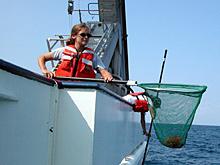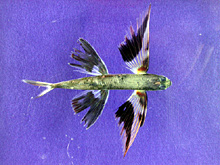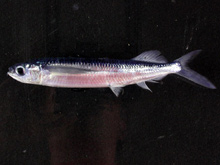Fantastic Flyingfishes
August 25, 2003
Tara Casazza
Research Biologist
North Carolina Coastal Reserve
Flyingfishes are a unique group of fishes because they possess the ability to launch themselves out of surface waters and glide or "fly" through the air, using their tails and their large, wing-like pectoral fins to keep them above the water. It is not yet known whether they fly to escape large predators, like dolphinfishes (mahi mahi) and dolphins (mammals), or whether it's an energy-saving mechanism. We still have much to learn about these fantastic fishes.
The science team is interested in this group of fishes because we suspect that they constitute an important ecological link in the open ocean ecosystems off the Carolinas. Little information exists about flyingfish feeding and reproduction, which is why we are conducting a sampling study. We plan to collect flyingfishes in or near the Gulf Stream current off North Carolina, to evaluate species composition, relative abundance, diets, and reproductive data, and then compare our findings to what is already known.

Dip netting is a sampling technique used to collect the notoriously difficult-to-catch flyingfish. Click image for larger view.
Flyingfishes occupy a unique niche in oceanic surface waters, but are extremely difficult to collect. We have attempted several methods, including neuston nets, dip nets, cast nets, night-lighting, and gill nets. Of these methods, only the neuston net, dip netting and night-lighting have been effective. Flyingfishes are extremely attracted to light (phototrophic), which is why dip netting at night with bright lights (night-lighting) is an effective method for collecting both juveniles and adults. It is truly the only way we effectively collect adult flyingfishes.
The flyingfish family (Exocoetidae) is very diverse, and 15 species are known to reside off North Carolina. At this point, we have collected more than 1,500 flyingfishes off Cape Hatteras, Cape Lookout, and Cape Fear, NC. We have also collected one species that had never before been collected off North Carolina.
After collecting the fish, we identify, measure, weigh, and determine the sex of each fish and then dissect the stomach and identify each food item found in it. Our reproductive data to this point on the expedition shows that some of our specimens were nearing spawning. Also, we have found that the diets of flyingfishes are diverse and that they do not all compete for the same food items. Juvenile flyingfishes eat small food items, such as copepods and chaetognaths, and adult flyingfishes eat larger food items, such as pteropods, crustaceans, and fishes.
Juvenile flyingfishes look very different from adults and have specialized morphology (body parts) that assist them with survival in the vast open ocean. Some juvenile flyingfishes are camouflaged to look like and blend in with Sargassum, a large, floating brown algae that provides food and protection in an otherwise barren area. Other juveniles have specialized appendages coming off their lower jaws, called barbels, which they use to feed in Sargassum.
Flyingfishes are an important resource within the trophic ladder and commercially, as well; they encompass a major commercial industry in some areas of the Caribbean, and are an important food source for commercially important dolphinfishes. Flyingfishes are also a dominant food item found in the stomachs of dolphins.
Although our study is presently limited because we only sample in the summer, we are optimistic about the information we will continue to glean from this effort and from similar, future efforts to obtain a more complete picture of these fantastic fishes.























